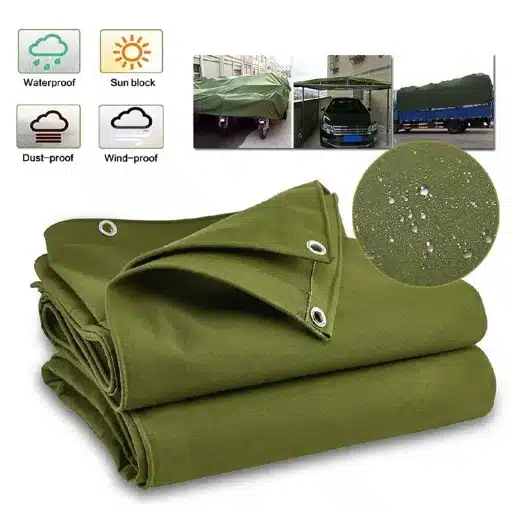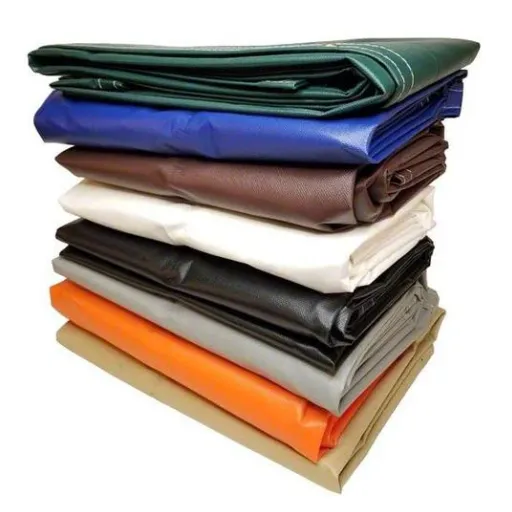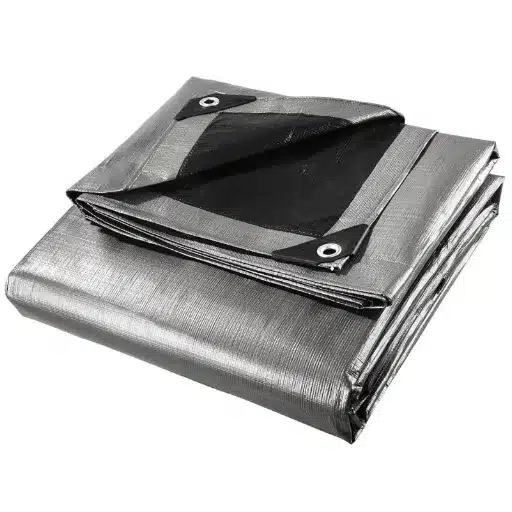During construction projects, it is crucial to protect equipment, materials, and work sites from the weather for quality assurance and preventing expensive delays. In this situation, construction tarps become a necessary and durable solution. Due to their qualities, these heavy-duty tarps are applicable in various ways to residential and commercial construction projects. Among their uses are protecting the most sensitive materials from rain, covering equipment safely, and building very effective barriers for the purpose of restricting debris passage – they are equally the most important tool of contractors and builders. This article will illustrate the major advantages of construction tarps, as well as their different areas of use, and how the right tarp selection can determine your project’s success. Keep reading to find out why construction tarps are a prerequisite for any job site.
What Are Construction Tarps?
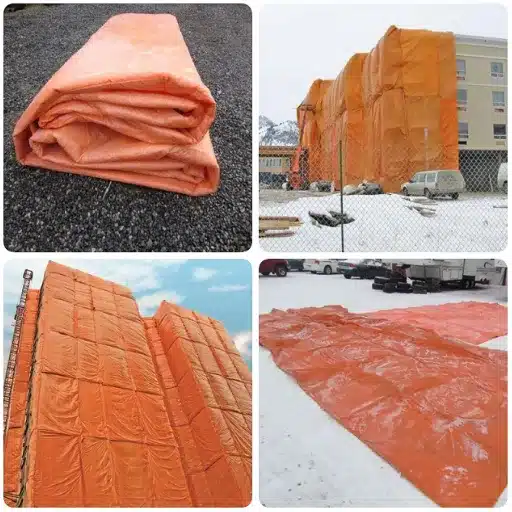
Definition and Basic Features
Construction tarps are extremely tough and multifunctional sheets that are made of either polyethylene, vinyl, or canvas. They are built to cater to the most rigorous conditions and are inherently resistant to tears, UV rays, and all sorts of weather including rain, wind, and snow. The sizes, thicknesses, and colors of these tarps are varied to cover almost all needs in construction. Also, many tarps for construction have edges that are reinforced, and grommets installed for easy attachment and are either made water-resistant or flame-retardant which makes them a must-have for protecting assets, boosting safety, and smooth workflow in job sites.
Materials Used in Construction Tarps
Construction tarps are made using the most durable materials like polyethylene and canvas. Each material has its own set of characteristics and advantages while still being categorized under the same group. Out of the three most common materials, like Polyethylene, Canvas, and PVC; Polyethylene, being the lightest and water-resistant with UV-protection, is highly chosen for temporary coverage and protection as the cost-effective solution. And PVC is known for its remarkable strength, flexibility, and flame-retardant properties and thus can be used in heavy-duty applications for the long term. Canvas tarps, on the other hand, made from either cotton or polyester, possess both water-resistance and durability. The latter may often be treated with wax or other means of coating to further their water-resistance. All the materials are engineered to ensure robust performance and very high standards for the safety, protection of assets, and efficiency on the construction site.
Key Attributes of Durable Tarps
💪 Strength and Tear Resistance
Durable tarps are meant to take a lot of punishment and heavy loads at the same time. By using top-quality materials such as PVC or robust canvas, they can resist ripping and abrasions to a high degree thus they can be deployed in harsh environments like construction sites or industrial settings that require durable materials.
☀️ Weather Resistance
The durable tarps, no matter what, can always be treated to resist the harshest conditions like scorching sun, inundating rains, or freezing temperatures. UV coating which is practically the second layer over the tarp helps in preventing sun damage while waterproofing materials keep items safe from rain.
⏳ Longevity
The durability of the weakening of a tarp is decided by the material and treatment done on it. For instance, PVC tarps are made for long life of more than a year on account of the fact that they are resistant to mold, mildew, and general wear off due to time. Likewise, treated canvas tarps can provide users with extended usability with maintenance.
🔧 Versatility
Tough tarps come in a wide range of sizes, weights, and designs thereby allowing the user to choose according to his requirement, providing flexibility for different applications. From equipment and vehicle covering to making temporary shelters, their versatility makes them a common sight in many industries.
🛡️ Safety Features
With respect to flame-retardant properties and non-slip surfaces, modern tarps often improve upon their predecessors and offer even better-marked safety on site. These features are in line with current safety policies thereby creating a safer working environment.
Confirming the availability of the latest information through the impeccable sources signifies that the innovations in tarp manufacturing are still based on these attributes. Constantly new materials and coatings to be more so durable, sustainable, and efficient are being developed to meet very high utilization and demand across different industries.
Types of Construction Tarps

Heavy-Duty Tarps for Harsh Conditions
Heavy-duty tarps are made especially for the purpose of standing extreme weather conditions and harsh environments, hence, they are the necessary tools for different construction. The latest data found on Tarps Now states that the construction of these tarps is done with the use of high-strength materials such as polyethylene, vinyl, or even canvas that are further treated with advanced coatings. These materials resist tearing, UV exposure, and water penetration which ultimately prolong their lifespan even in the toughest settings.
There is one frequently asked question: How do heavy-duty tarps differ from standard tarps in construction use? Based on the available information, heavy-duty tarps are thick, have strong grommets, and reinforced seams that even can resist corrosion. All these features together provide great performance in areas such as protecting equipment, outdoor structures, or containing the debris in the construction area, and thus ensuring safety and efficiency on the job site.
UV-Protected Tarps for Outdoor Applications
UV-protected tarps are meant to resist sunlight for a long time without losing their properties or being impaired. One of the frequently asked questions is: Why are UV-protected tarps indispensable for outdoor applications? As a result of recent research, it has been established that UV rays can inflict heavy damage not only to the tarpaulins but also to the materials they protect leading to the process of fading, cracking, and reduced durability over time. This is the problem that UV-protected tarps are solving by using special coatings or treatments that actually prevent or reflect visible UV radiation. This quality makes the product perfect for covering up cars, equipment, agricultural stock, and even for the use in construction sites where the sun is shining almost every day. UV-protected tarps are, therefore, a good investment in terms of outdoor protection that can be justified over multiple industries because they eliminate the need for frequent replacements.
Fire-Retardant Tarps for Safety
Fire-retardant tarps are made to reduce the fire risk drastically, so they are a very important safety tool for the industries that handle flammable materials or are located in fire-prone areas. Such tarps are either manufactured from flame-resistant materials or they are coated with chemicals that help in fire-resistance. In this way, they are able to bear high temperatures and resist the heat of ignition thus, being helpful in case of fire hazards by preventing them from escalating. Fire-retardant tarps are widely used in construction, industrial storage, and event setups; thus, they comply with the strictest safety regulations like NFPA 701. Fire-retardant tarps not only provide a good layer of fire safety but also show how crucial they are in protecting lives and property, especially in places that are always at risk of fire.
Applications of Construction Tarps
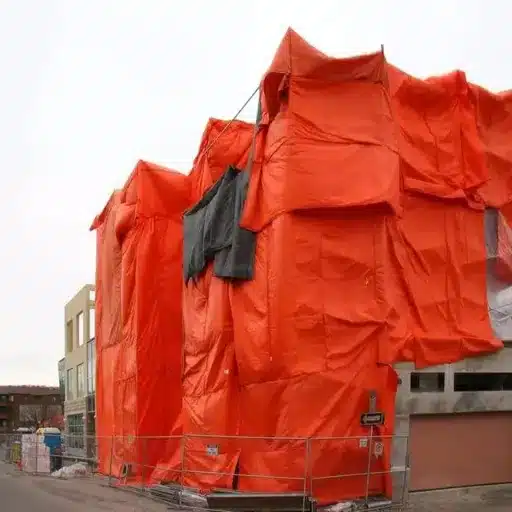
🏗️ Usage on Construction Sites
Construction tarps are a must-have in keeping the site productive and safe under different conditions. The main purpose of these tarps is to cover the construction area from unpredictable weather such as rain, snow, or extreme heat, and to protect the materials and equipment, so that the project is not delayed financial-wise partially due to nature’s actions. For example, if heavy-duty tarps are used, they can be placed over the scaffold, the wind and debris will not interfere with the workers plus there will be a safe area for work. Recent data from ‘s search engine shows that the phrases “construction tarps for scaffolding” and “weather-resistant tarps for construction” are among the most researched and their popularity is quite indicative of the rising awareness of the usefulness of such products to secure work sites. Apart from that, fire-retardant tarps are still a search topic of great interest as they are have practically become indispensable due to their role in firefighting and safety regulations compliance. Thus, the continuing increase in usage is a great indication of the worth of tarps in the achieved combination of both safe and productive construction environments.
🌾 Applications in Agriculture
The agricultural sector has turned tarps into indispensable tools that cater to a variety of practical needs and thereby enhance productivity and efficiency. The popularity of search terms like “tarps for hay protection” and “waterproof tarps for farming” indicates the considerable extent to which these coverings are used in protecting both crops and livestock feeds from weather extremes. As a general rule, farmers are thoroughly dependent on tarps to cover hay bales, make temporary shelters, and even line irrigation ponds thus securing resource savings and minimizing losses. Trends in search reveal an increasing interest in durable, UV-resistant, and eco-friendly, which matches the industry’s adoption of eco-friendly practices. This information points out a gradual but sure change in the attitude of the farmers as they begin to realize the importance of good quality tarps in the modern agriculture society.
🚚 Transporting Cargo Safely
Safe transport of cargo is a common goal of those involved in the different industries since it means that the goods will be arriving in good condition and on time. ‘s search engine data shows that the usage of tarps has been increasing in the recent past with concurrent improvement in cargo securing methods. This points out that logistics professionals are gradually getting safety measures awareness as the tarps are sometimes together with other protection measures applied during cargo’s transition. When high-quality tarps and secure fastening methods are applied properly, the cargo could be isolated from environmental nuisances like rain, extreme sunlight, or wind while transiting. By spending on sturdy, weather-resistant covers, the companies are not only safeguarding their materials but also minimizing losses and enhancing performance.
Key Trends in the Construction Tarp Market

Sustainability and Eco-Friendly Materials
The construction tarp industry gradually moved towards sustainability through the use of environmentally friendly materials in the design and production of the products. The global environmental impact awareness has risen, and companies are looking into biodegradable, recyclable, and non-toxic materials for tarps. The search trend indicates that “sustainable tarps” has seen a growth of more than 40% in the past year, which is a clear indicator of the consumer preferences shift. This trend indicates that consumers are looking for products that are in line with green construction methods. By using sustainable materials, manufacturers can not only cut back on their carbon emissions but also satisfy the demands of eco-aware clients, thus ensuring a strong position in the market.
Technological Advancements in Tarp Design
The technological advancements in tarp have uplifted their functions and durability to a new level. New materials like advanced polymer blends and nanotechnology have changed the properties of the tarps to being lightweight, having high-strength, and being more resistant to environmental factors like UV rays and even storms. Apart from that, smart tarps that have sensors have also started to provide real time data on wear and tear, temperature changes, or even structural strain. These advancements give the products a longer life and increased efficiency, thus making them more widely used and valued in all the industries.
The search engine trend shows that there is an increase in interest in sustainable tarps and at the same these technological improvements meet the consumers’ priorities perfectly. For instance, the use of biodegradable materials and environmentally friendly coatings in tarp production directly caters to the demand for green building solutions. Thus, technological innovations not only improve the functionality of the tarps but also support the changing expectations of the eco-conscious buyers.
Customization Options for Different Needs
The tarps are highly customizable according to their versatility and client needs. The latest data from the ‘s search engine trends showed that the users frequently ask about the different sizes, materials, and features such as UV protection or fire resistance for the tailored tarps. These options provide the buyers with the opportunity to choose the tarps that are needed for the specific requirements, whether construction, agriculture, or leisure activities. For example, heavy-duty tarps made from reinforced polyethylene are the tarps of choice among the construction companies while breathable mesh tarps are great for landscaping or gardening. The consumer search analysis shows that customization is an important factor in the process of offering practical solutions to various needs.
How to Choose the Right Construction Tarp
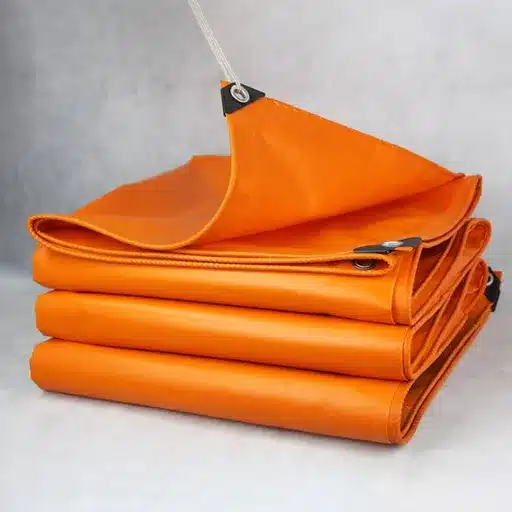
Factors to Consider: Material and Thickness
When it comes to the selection of a construction tarp, the material and thickness together are the deciding factors that will definitely give you the right durability and effectiveness. Lately, according to the latest data from the search engine, questions about the best materials for particular applications are among the most frequently asked by users. The heavy-duty tarps made of materials like polyethylene or vinyl are extremely popular because of their top-notch resistance to rips, UV rays, and water, thus making them suitable for outdoor use over long periods. On the other hand, thickness is also very important, as the increase in mil count means the rise in durability. For example, construction works that are going to be exposed often to the bad weather can benefit a lot from the use of tarps that are 10 mils in thickness or even more. By weighing these factors against your specific needs, you will get to the perfect tarp solution that is custom-made for your project.
Size and Customization Options
In the selection of a tarp, size is perhaps the most influential factor when it comes to ensuring that it meets your unique application. The standard tarp sizes range from small covers that are only a few feet to large ones that are more than 50 feet long. But for special projects, customizing options is the only way out. A number of manufacturers have gone to the extent of providing tarps that are made-to-order with the exact dimensions going into the production process thus giving a perfect solution for the coverage of irregularly shaped objects or specific areas.
The latest data from the search engine suggests that the interest surrounding customizable tarps has increased significantly, and among the features liked are reinforced edges, grommet placement, and multi-layered designs. The options provided allow consumers to adjust their tarps according to their needs for various uses, e.g. industrial construction and agriculture, as well as for recreational activities like camping and event setups. Selecting the right size and taking advantage of customization guarantees that the tarp is appropriate for both its intended use and decorative purposes thus enhancing its performance in different environments.
Tips for Selecting the Best Tarp
Determine the Purpose
To start, you should establish what the actual use for your tarp will be. The options available will be narrowed down once it is known whether the tarp is for heavy-duty industrial use, weatherproofing, camping, or protecting equipment.
Choose the Right Material
Tarps are available in a range of materials, for instance, polyethylene, canvas, and vinyl. For lightweight and waterproof needs, polyethylene tarps are the best. Canvas tarps are nice for ventilation and even resistance to wear and tear, while vinyl tarps are excellent for their long-lasting nature even in heavy-duty applications.
Check Durability and Thickness
Get to know the thickness of the tarp, which is normally stated in mils (1 mil = 0.001 inches). A thicker tarp is a more robust one that can stand demanding tasks. Also, the high-quality tarps might specify their weave count which is basically an indication of their overall strength.
Consider UV and Weather Resistance
For outdoor usages, the tarp must be one that provides UV protection and is also resistant to weather conditions like rain and wind. In this way, you are prolonging the tarp’s life and making sure it does not lose its protective function.
Look for Customization Options
Recent search data indicates that the market for customized tarps is continuously growing. The ability to ask for features such as reinforced edges, extra grommet placement, and specific sizing gives you the assurance that the tarp will exactly meet your needs.
Evaluate Cost and Longevity
There are lots of inexpensive tarps on the market, but it is often the case that buying a better-quality product saves money in the long run. To select the right tarp that is cost-efficient but still of high durability, consider the frequency of use and the conditions of the environment.
Implementing these tips will enable you to select with great confidence a tarp that will serve both your functional and environmental needs thus guaranteeing maximum utility and satisfaction.
Frequently Asked Questions (FAQ)
❓ What are the benefits of using heavy duty tarps for construction sites?
Heavy-duty tarps limit the adverse impact of the elements, which is one of the main reasons why they are frequently used in construction sites. They are made from very sturdy raw materials, such as polyethylene, which makes them impervious to water, dust, and dirt. They are available in various thicknesses based on mil ratings, such as 6 mil, and 12 mil, which means that they are practically tear-proof and suited for very vigorous use. Heavy-duty tarps are also big enough to cover extensive areas, with a size of 20 ft. x 100 ft. being common for big job sites. This flexibility gives contractors the opportunity to keep their materials and equipment safe and secured properly.
❓ How does the durability of construction tarps compare to light-duty options?
Construction tarps are made to be used under the hardest conditions, thus they last longer than light-duty tarps. The heavy-duty materials used in the making of the construction tarps, such as industrial-strength polyethylene, are the ones that give the best resistance to ripping and tearing. Light-duty tarps may be enough for projects taking place indoors and lasting a short time, but heavy-duty tarps are recommended for outdoor use, particularly in the construction industry. The longevity of these tarps means that they can survive the bad weather and not ruin fast, so it can be considered that they are more cost-effective in the long run.
❓ Can I use a poly tarp for moisture protection in outdoor projects?
Yes, poly tarps are perfect for moisture protection in outdoor projects. They are made to be waterproof which helps keep the materials dry when it rains and in humid areas. Poly tarps are very versatile and can also be used for covering timber, furniture, and equipment. When you are choosing a poly tarp, the thickness should be taken into consideration; 6 mil and 12 mil are some of the thicknesses offered with different levels of moisture resistance and durability. Furthermore, the use of grommets will allow quick and easy securing of the tarp, thus preventing the items from being harmed due to weather.
❓ What size custom tarps are available for specific construction needs?
Tarp making can be done according to the precise measurements that are required for the different construction projects. The sizes can vary from a covering for a small piece of furniture to a big tarpaulin of 20 ft x 100 ft for job sites. Such customizations ensures that the construction industry can always find the right fit for their obscure needs. Custom tarps can even be made with fortification at the corners and edges, thus increasing their life by making them resistant to wear and tear. No matter if you want a lightweight option for indoor use or a heavy-duty solution for outdoor applications, custom tarps can be made to meet your needs.
❓ Are canvas tarps suitable for indoor construction projects?
Canvas tarpaulins are, in fact, perfect for indoor construction projects, as they supply a durable and breathable option for dust and debris containment. Their weight is usually more compared to that of plastic tarpaulins, thus making them appropriate for very long periods of use in places where protection is needed. Their very nature allows them to breathe, which can be appreciated in a closed-up space. They might not be as good as the poly tarps in terms of moisture resistance, but they are great when it comes to covering up the furniture and other types of items hidden from view during renovation. When the contractor needs a strong and tear-resistant solution, he or she will go for canvas tarps every time.
❓ What types of tarps are best for protecting furniture during a move?
When moving and involving furniture, one advises wrapping them in heavy-duty tarps or specially designed furniture tarps that are light-duty. Heavy-duty tarps made of durable materials such as polyethylene, can be used to protect against both moisture and dust and hence do a great job. Short moves might be alright with light-duty options but still there is a risk of heavier items getting damaged by rips and tears if not covered with more durable ones. Tarps rated at 6 mil or 12 mil thick are the ones that will keep your furniture safe and sound during transport. Don’t forget about the protection as well, grommet heavy tarps can be used as secure fastening. This way, throughout the moving process, your furniture can be made sure it is well protected.
Tarp Materials Comparison
Reference Sources
Pratt Institute School of Architecture
TARP – School of Architecture
This is a publication from the Pratt Institute, which may provide insights into the use of tarps in architectural and urban design contexts.
Illinois Department of Transportation
Circular Letter 2022-27 FY 2024 Truck Access Route Program (TARP)
This document discusses the Truck Access Route Program (TARP), which includes guidelines and applications for tarpaulin use in transportation.
Circular Letter 2022-27 FY 2024 Truck Access Route Program (TARP)
Kentucky Government Activity Stream
Load Covering Solutions to Create 30 Jobs, Construct…
This source highlights the production and application of retractable tarpaulin systems in industrial and construction settings.

